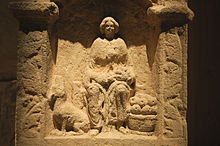Nehalennia
She is attested on and depicted upon numerous votive altars discovered around what is now the province of Zeeland, the Netherlands, where the Schelde River flowed into the North Sea.
De Stempel (2004) links her name with Welsh halein "salt" and heli "sea", proposing a Celtic origin.
[1] Nehalennia is attested on 28 inscriptions discovered in 1645 in the Dutch town of Domburg on the Zeeland coast, when a storm eroded dunes.
Several sporadic spellings, which are attested once each, were considered by Bogaers as non-standard or rejected as misread, due to the poor state of some of the inscriptions.
Gysseling holds that some spellings are a transliteration, an attempt to approximate the pronunciation of her name in Latin script, suggesting that the "h" may have been pronounced as some German ch sound.
[8] With the linguistic tools then available, Van Boxhorn attempted to bridge the already-known connections between European languages and modern Persian.
[12] Hilda Ellis Davidson describes the votive objects: Nehalennia, a Germanic goddess worshipped at the point where travellers crossed the North Sea from the Netherlands, is shown on many carved stones holding loaves and apples like a Mother Goddess, sometimes with a prow of a ship beside her, but also frequently with an attendant dog which sits looking up at her (Plate 5).
In Värmland, Sweden, "within living memory," there was a custom of grain from the last sheaf of the harvest customarily being used to bake a loaf in the shape of a little girl; this is subsequently shared by the whole household.
Davidson provides further examples of elaborate harvest loaves in the shape of sheaves, and displayed in churches for the fertility of fields in Anglo-Saxon England, with parallels in Scandinavia and Ireland.
The design of temple and its sculpture is based on the finds from the nearby area, as well as archaeological study of the type of sanctuaries in the Roman provinces of Gaul and Germania.
[16] Religious practices surrounding Nehalennia were at their peak in the 2nd and 3rd centuries AD, at which time there were at least two or three temples located in the area of what is now Zeeland.





